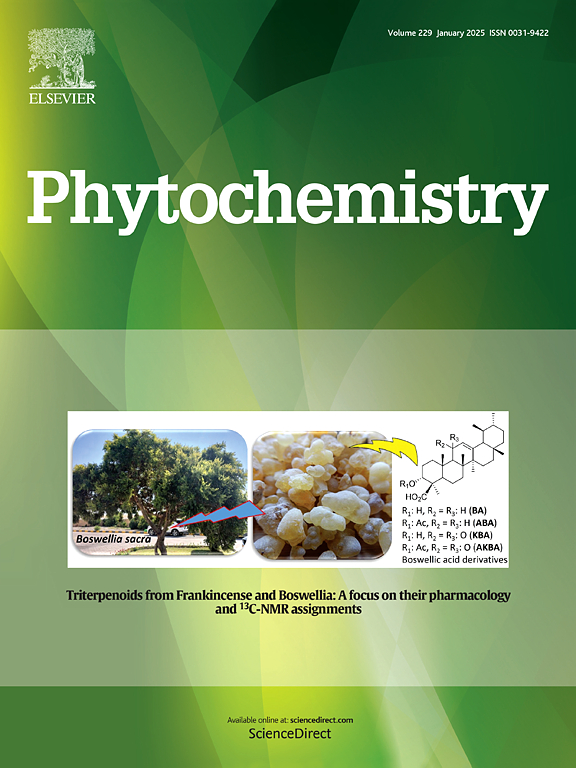Eight previously undescribed flavonoids and four previously undescribed bibenzyls from Macaranga kurzii and their potential antiviral activities
IF 3.4
2区 生物学
Q2 BIOCHEMISTRY & MOLECULAR BIOLOGY
引用次数: 0
Abstract
Eight previously undescribed flavonoids, named makurziis A-H (1–8), four previously undescribed bibenzyls, named mayankurziis A-D (9–12), as well as nine known compounds were isolated from the ethyl acetate extract of dried stems and leaves of Macaranga kurzii. Their structures were thoroughly elucidated through detailed spectroscopic analysis and comparison with existing literature data. Additionally, the structures of compounds 3 and 7 were further confirmed by single-crystal X-ray diffraction analysis. Biological testing revealed that compound 1 exhibited low cytotoxicity and potent anti-Zika virus (ZIKV) activity, with an EC50 value of 2.546 μM. Similarly, compound 8 displayed low cytotoxicity and strong potential against dengue virus (DENV), with an EC50 value of 3.092 μM. The quantitative real-time PCR and immunofluorescence analysis collectively showed that compounds 1 and 8 exhibited good in vitro antiviral activity at both the protein and RNA levels by suppressing the expression of ZIKV and DENV envelope protein.

八种黄酮类化合物和四种联苯类化合物及其潜在的抗病毒活性
从马卡兰干茎叶的乙酸乙酯萃取物中分离得到8个先前未描述的类黄酮,命名为makurziis A-H(1-8), 4个先前未描述的联苯,命名为mayankurziis A-D(9-12),以及9个已知的化合物。通过详细的光谱分析和与现有文献资料的比较,彻底阐明了它们的结构。此外,化合物3和7的结构通过单晶x射线衍射分析得到进一步证实。生物实验表明,化合物1具有较低的细胞毒性和较强的抗寨卡病毒活性,EC50值为2.546 μM。化合物8对登革热病毒(DENV)具有较低的细胞毒性,EC50值为3.092 μM。实时荧光定量PCR和免疫荧光分析结果表明,化合物1和8通过抑制ZIKV和DENV包膜蛋白的表达,在蛋白和RNA水平上均表现出良好的体外抗病毒活性。
本文章由计算机程序翻译,如有差异,请以英文原文为准。
求助全文
约1分钟内获得全文
求助全文
来源期刊

Phytochemistry
生物-植物科学
CiteScore
6.40
自引率
7.90%
发文量
443
审稿时长
39 days
期刊介绍:
Phytochemistry is a leading international journal publishing studies of plant chemistry, biochemistry, molecular biology and genetics, structure and bioactivities of phytochemicals, including ''-omics'' and bioinformatics/computational biology approaches. Phytochemistry is a primary source for papers dealing with phytochemicals, especially reports concerning their biosynthesis, regulation, and biological properties both in planta and as bioactive principles. Articles are published online as soon as possible as Articles-in-Press and in 12 volumes per year. Occasional topic-focussed special issues are published composed of papers from invited authors.
 求助内容:
求助内容: 应助结果提醒方式:
应助结果提醒方式:


